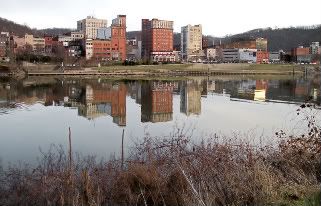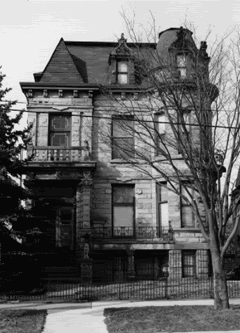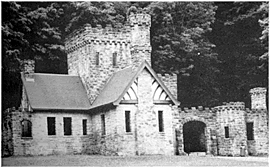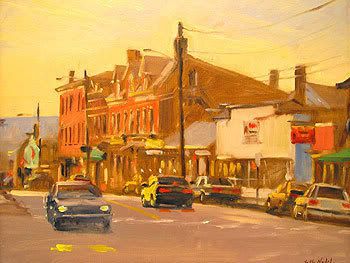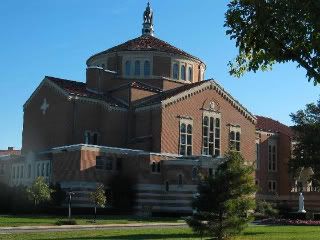
Basilica of Mother Seton from Virtual Tourist
We're on the last lap of our spook-seeking trip outside the state, and we're making our final stop at Mount St. Mary's College in Emmitsburg, Maryland. There's something about Catholic schools that spirits just love.
In 1805, a circuit-riding priest named John DuBois was on the road between Frederick and Emmitsburg. He saw a light on a mountain and, thinking it was a farmhouse, rode toward it.
Father DuBois couldn't find the house, and laid his weary bod down and went to sleep. When he woke, he saw a breathtaking vista of rolling hills and fields. He decided to stay there and build a church and a school.
The school, founded in 1809 because of a vision of a ghostly light, was Mount Saint Mary's.
If you stand in the quad facing Brute Hall, you're right in the center of spook central. You may bump into the ghost of the Rev. Simon Brute, an early president of the college who died in 1839.
Legend has it that Father Brute still strolls the campus wearing long black robes. He's been seen following groups of students. Father Brute usually just smiles and nods when acknowledged by the living.
Glance up at the second floor and you'll see the window of Room 252. Once a year, the spirit of Father Brute shares that dorm room with the lucky resident. But the rest of the time...
There's a tale of a priest who lived in Room 252 about 30 years ago. One night the priest straightened his room, stepped out for a few minutes, then returned to find everything — bedclothes, furniture, books and papers — in total disarray. The priest discovered that his lights and TV flashed on and off at random times. He moved out.
Another priest took the room. But when his pet cat began hissing at odd times and scurrying under the bed to hide, he also took a powder.
Room 252 remained empty for years. In 1997, three students moved in. They noticed odd occurrences like a falling mirror and a self-flushing toilet. The TV changed channels by itself. School workmen later put in a bookshelf. Glasses and books fall off the shelves for no reason in the middle of the night. The unknown poltergeist of Room 252 is still around to this day.
One of our visitors posted that "Brute (and Terrace as a whole) is definitely haunted. One of my roommates was watching TV (with the remote on the table) and watched as the menu flashed onto the TV and the settings were changed before him."
"My other roommate and I have both experienced multiple encounters in the restroom adjacent to our room, mainly past 2 AM. We both have been in there, and have been the only ones in there, and the stalls all close at once (it's a loud sound you cannot mistake it). I've also heard whispers and whistling inside closed door bathrooms only to find them empty."
The post went on: "One of my better encounters occurred down the hall in Dubois, where the hot bed of activity mainly occurs. Friends have reported flushed toilets, shades being pulled up and down, etc. etc. I was going there to get my keys from there which I had left the night before and was about to knock on the door. I heard voices coming from their side of the suite so I figured they must be in there."
"The voices were unmistakeably clear and could not be discounted as just wind or anything else. I kept banging telling them to open and the voices stopped. Then, as I turned around to leave, who walks down the hall but my friends. They said no one was in the room and when they opened the door the TV and music was off. I gladly took my keys and left."
Adjacent to Brute Hall, McCaffrey Hall is another high-spirited building. A slave named Leander who worked for the college in the mid-1800s lived on the first floor of the hall. He was accused of stealing and as punishment, his left hand was cut off and buried in the quad.
Eventually, Leander was freed and stayed on at the college as a workman. When he died, he was buried in the school's cemetery.
Residents of McCaffrey report seeing a severed hand scuttering about, or hearing fingers scratching on dorm windows. They believe that it's the ghostly hand of Leander trying to find its way back to the rest of his body.
One of the college's more famous ghosts is a nameless Civil War soldier who promised his beloved that he would think of her while he was gone. The pair looked to the heavens and vowed to gaze upon the same star every evening.
The soldier was killed in battle and was buried face down in an old well. Now his spirit, people say, roams Mount Saint Mary's campus, tapping startled folks on their shoulders and pleading with them to "turn me over." He wants to see the star.
Larry is another famous St. Mary's legend. His father, the school music director Larry Dielman Sr., wanted him to be a musician like himself, but junior had a tin ear and became a grocer. In the late 1800s, his father died.
The next Christmas, Larry took his flute and went to the cemetery at Mount St. Mary’s to play one of his father’s pieces, “When the Glory Lit the Midnight Air” (or, according to some, "Adestes Fideles", which his dad played for the students every Christmas morning). It came out of his instrument beautifully. He found he could finally make music, if only at his father's graveside.
The town folk joined him and Larry would lead the people up to the cemetery each Christmas to play the flute. In the 1920s Larry died. Locals say that if you listen carefully on Christmas, you can still hear the spectral strains of flute music floating from the cemetery. Then the music is gone, not to be heard again until the next Yuletide.
Watching over the Grotto is a statue of Elizabeth Ann Seton, the first native born American to be sainted. She's dressed in a floor length cloak and bonnet, holding a Bible in one hand and rosary beads in another. She moved to Emmitsburg in 1809 at Father DuBois' invitation to establish the nation's first parochial school.
The ghost of Mother Seton, dressed in her nun's habit, still frequents the halls and grounds of the college.
Her spirit has often often spotted walking beside a man who looks like a doctor, carrying his black bag. Some say that her vision appeared to wounded soldiers during the Civil War, when the school was used as a hospital, and that she created a synergy with the doctor to heal the injured troops. Others believe that the man she's with is her father, who was a physician.
Saints and spooks are a Catholic tradition, and one that Mount St. Mary's carries on to this day.

